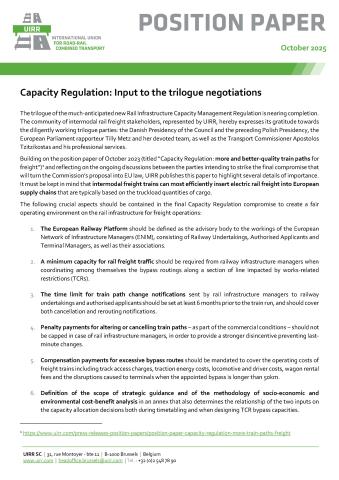
Brussels - 2 October 2025
Capacity Regulation: Input to the trilogue negotiations
The trilogue of the much-anticipated new Rail Infrastructure Capacity Management Regulation is nearing completion. The community of intermodal rail freight stakeholders, represented by UIRR, hereby expresses its gratitude towards the diligently working trilogue parties: the Danish Presidency of the Council and the preceding Polish Presidency, the European Parliament rapporteur Tilly Metz and her devoted team, as well as the Transport Commissioner Apostolos Tzitzikostas and his professional services.
Building on the position paper of October 2023 (titled “Capacity Regulation: more and better-quality train paths for freight”)* and reflecting on the ongoing discussions between the parties intending to strike the final compromise that will turn the Commission’s proposal into EU law, UIRR publishes this paper to highlight several details of importance. It must be kept in mind that intermodal freight trains can most efficiently insert electric rail freight into European supply chains that are typically based on the truckload quantities of cargo.
The following crucial aspects should be contained in the final Capacity Regulation compromise to create a fair operating environment on the rail infrastructure for freight operations:
- The European Railway Platform should be defined as the advisory body to the workings of the European Network of Infrastructure Managers (ENIM), consisting of Railway Undertakings, Authorised Applicants and Terminal Managers, as well as their associations.
- A minimum capacity for rail freight traffic should be required from railway infrastructure managers when coordinating among themselves the bypass routings along a section of line impacted by works-related restrictions (TCRs).
- The time limit for train path change notifications sent by rail infrastructure managers to railway undertakings and authorised applicants should be set at least 6 months prior to the train run, and should cover both cancellation and rerouting notifications.
- Penalty payments for altering or cancelling train paths – as part of the commercial conditions – should not be capped in case of rail infrastructure managers, in order to provide a stronger disincentive preventing last-minute changes.
- Compensation payments for excessive bypass routes should be mandated to cover the operating costs of freight trains including track access charges, traction energy costs, locomotive and driver costs, wagon rental fees and the disruptions caused to terminals when the appointed bypass is longer than 50km.
- Definition of the scope of strategic guidance and of the methodology of socio-economic and environmental cost-benefit analysis in an annex that also determines the relationship of the two inputs on the capacity allocation decisions both during timetabling and when designing TCR bypass capacities.
Requests explained
- The European Railway Platform (ERP) should review the implementation documents produced by the European Network of Infrastructure Managers (ENIM). These documents should serve as the basis of cross-border rail transport operations. The ERP should incorporate every railway undertaking and authorised applicant that runs or plans to run cross-border trains, as well as terminal managers that receive such trains, and their respective associations. This body should exist to fulfil the coordination of stakeholders during strategic capacity planning and to review the ENIM documents by the European Network of Rail Regulatory Bodies (ENNRB). The ERP should function transparently, be open to every qualifying participant, and any charges for ERP participation should be set on the level of the reasonable costs of its administration.
- A minimum capacity for rail freight should be mandated that reflects the difficulty of deterring cargo carried by rail from being transferred to other transport modes. This is especially important when bypassing sections of the line impacted by TCRs.
- The time limit for train path change notifications should be defined at 6 months in case of freight trains, meaning the definitive confirmation of the requested capacity should be confirmed at the latest 6 months before the scheduled train run. This is needed to reassure the customers of the train operation and to enable the railway undertakings, the authorised applicants and the terminal managers to make the necessary planning arrangements. Infrastructure managers should be severely disincentivised from deviating from this requirement.
- Penalty payments for short-notice changes or cancellation of train paths by the railway infrastructure manager are proposed to be capped in the commercial conditions of the Regulation. This cap means that making changes to a validly issued train path for a freight train is relatively cheap from the perspective of an infrastructure manager – especially if the alteration does not appear significant. Such changes are often perceived to be more significant from the perspective of a train operator, resulting in disruption and additional operating costs. The disincentivising impact of the penalty towards the infrastructure manager must be reinforced by removing the cap.
- Compensation payments for excessive bypass routes, to be paid by the infrastructure managers, are needed in case of bypass routes of 50km or longer, to assist the railway undertakings and authorised applicants to absorb the disruption caused by the excessive bypass route. The magnitude of the payment should be determined by the length and restrictions posed on freight trains using the section of line impacted by the TCR, and it should incorporate any additional track access charges, traction electricity costs, locomotive and driver fees, wagon rental costs and terminal disruption charges.
- The scope of the strategic guidance and socio-economic and environmental cost-benefit analysis should be defined in an annex to the Regulation, explicitly listing the types of unique instructions that a Member State government can issue. The Annex should contain a methodology description for the socio-economic and environmental cost-benefit analysis to be carried out in parallel. The practical rules pertaining to the two different inputs to capacity allocation should be detailed in the Regulation, primarily focusing on the issues of hierarchy, transparency and method of introduction (deadlines).
Download as a PDF below


